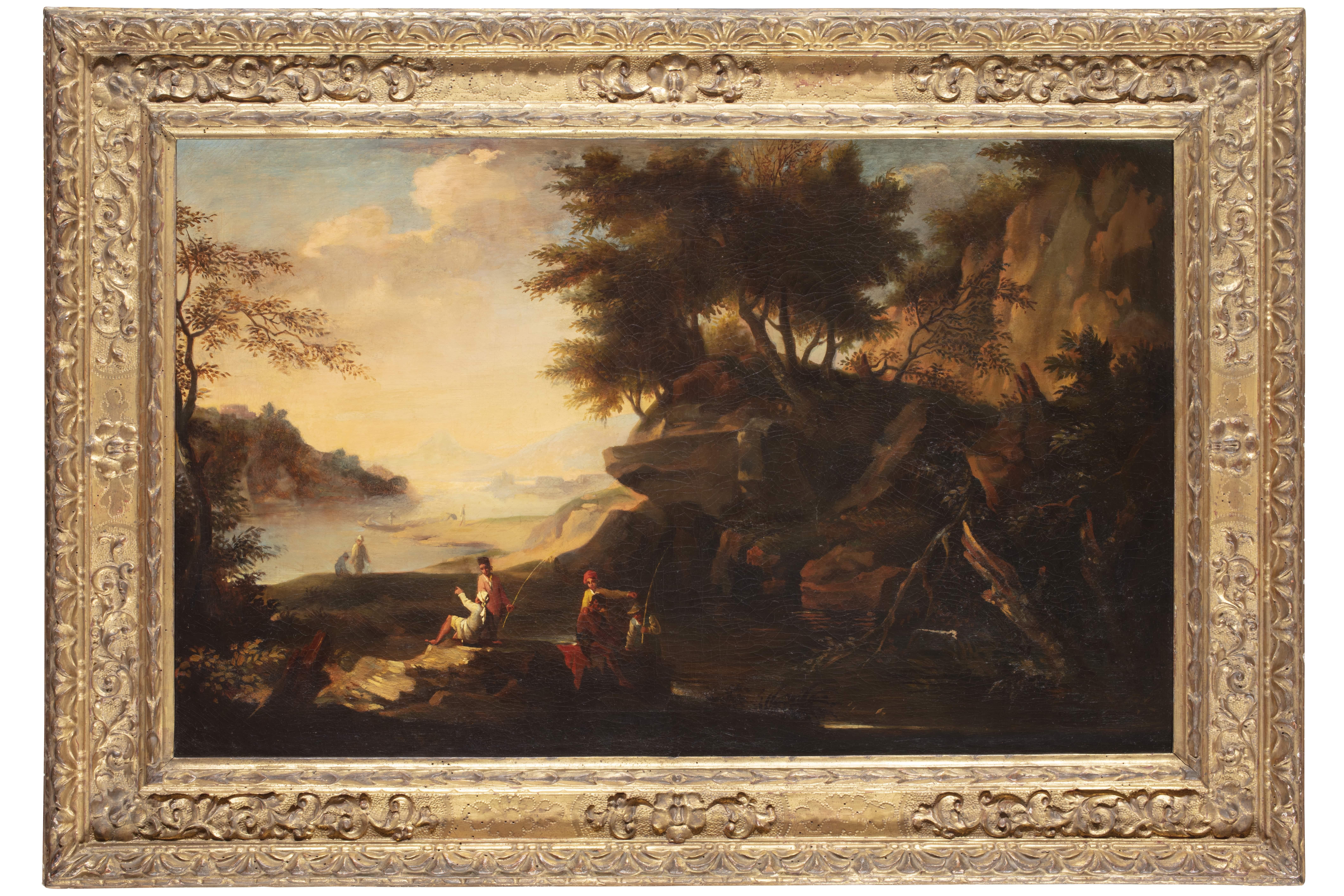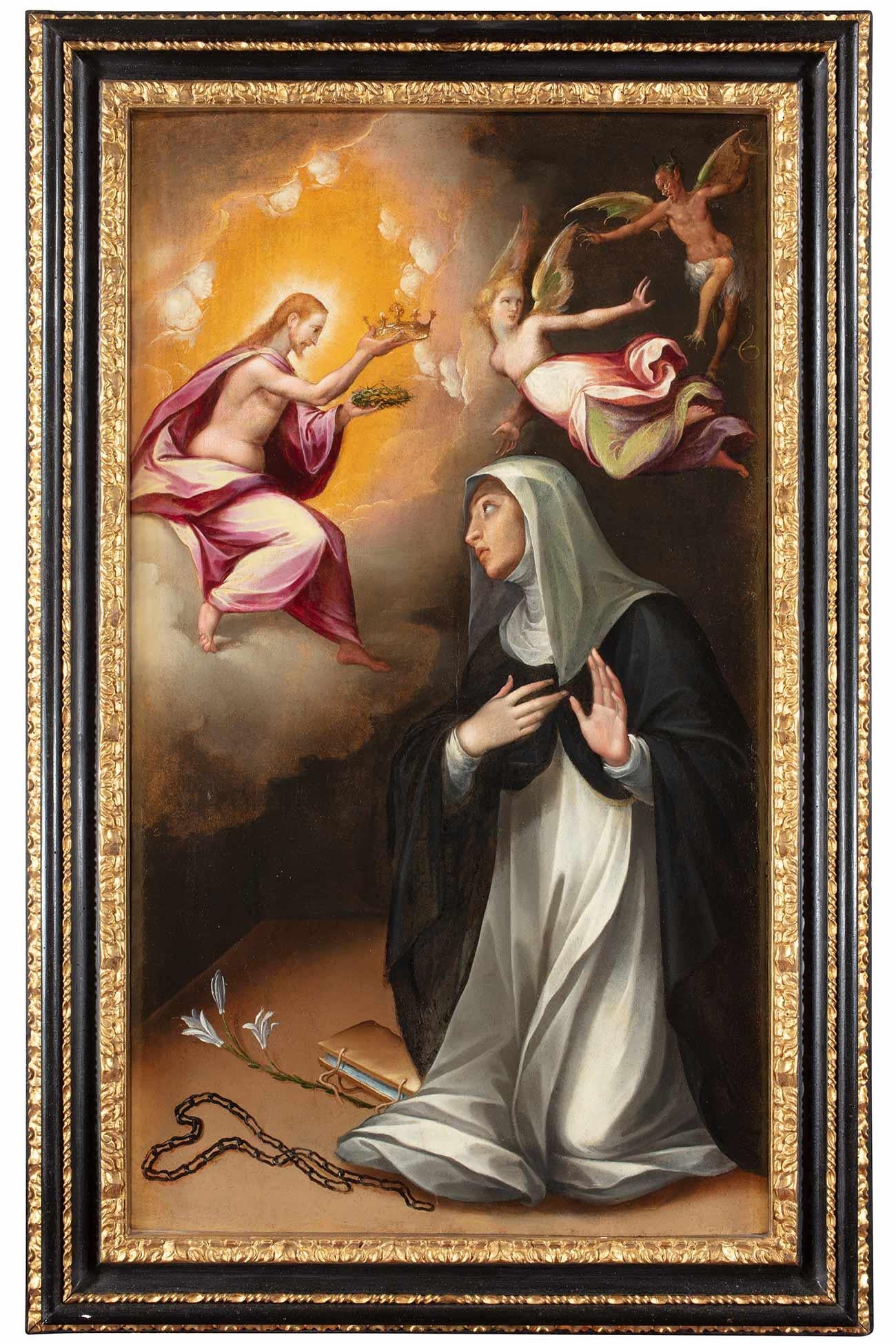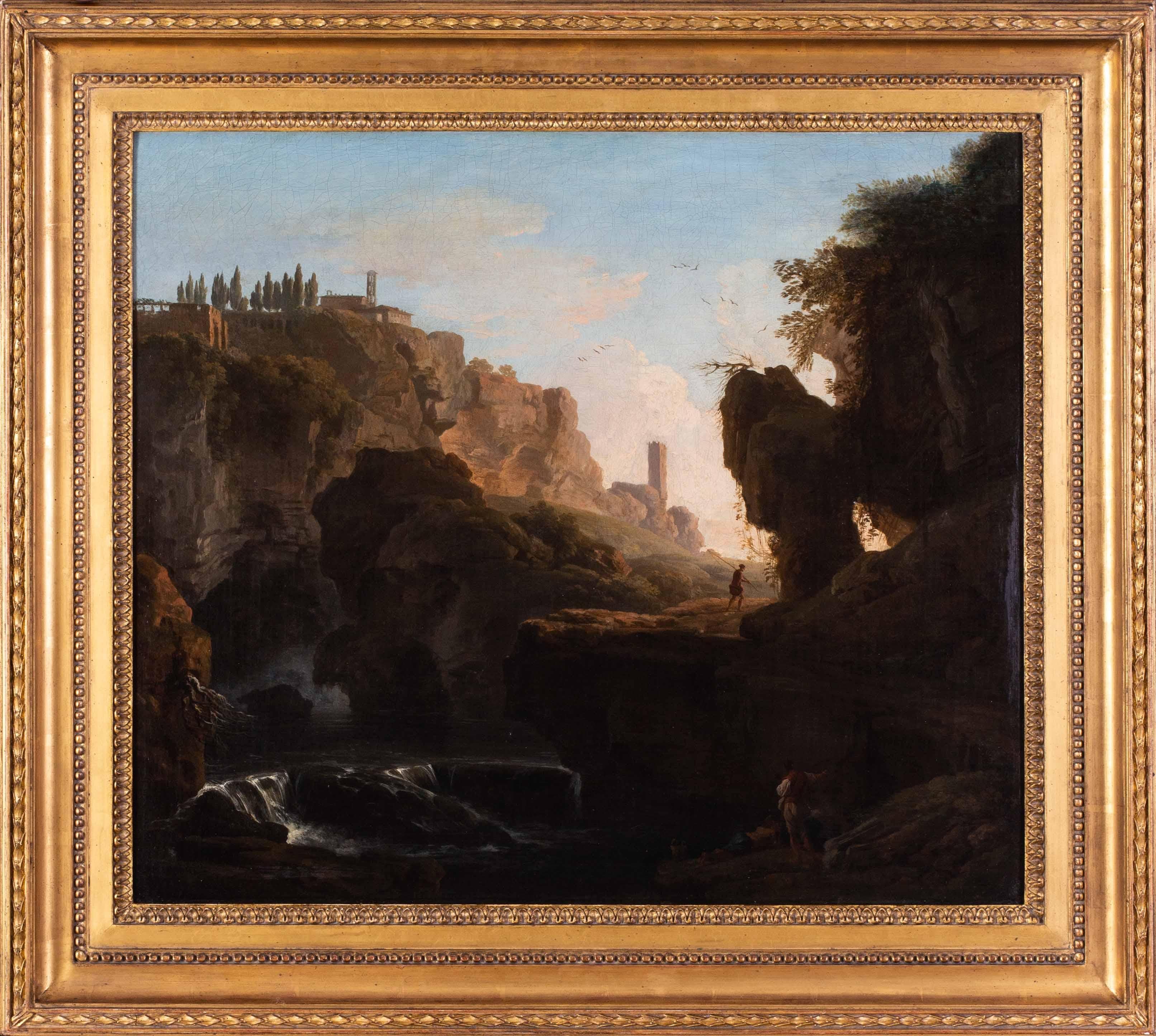Items Similar to VENICE - In the Manner of Canaletto -Italian Landscape Oil on Canvas Painting
Want more images or videos?
Request additional images or videos from the seller
1 of 14
Mario De AngeliVENICE - In the Manner of Canaletto -Italian Landscape Oil on Canvas Painting2006
2006
About the Item
Venice - Mario De Angeli - Italia 2006 - Oil on canvas cm. 70x90.
Mario De Angeli's canvas is an extraordinary work of Italian landscape painting. They are inspired by the landscape painting of Luca Carlevarijs, Canaletto's master, who dominated the Venetian market in 1700.
De Angeli's paintings are a tribute to the city of Venice which thus becomes a spectacle of visible reality.
In addition to the impeccable perspective and wise knowledge of architecture, the city is seen with a fantastic eye where water, a fundamental element, creates a variable and imaginary mirror game. Mario De Angeli's brushwork is precise, the touch is soft, the chromatic sense is accurate and varied. His painting creates excellent works, memories of precise places in beautiful Italy and at the same time memories of the heart.
- Creator:Mario De Angeli (1965, Italian)
- Creation Year:2006
- Dimensions:Height: 27.56 in (70 cm)Width: 35.44 in (90 cm)
- Medium:
- Movement & Style:
- Period:
- Framing:Frame IncludedFraming Options Available
- Condition:
- Gallery Location:Napoli, IT
- Reference Number:1stDibs: LU56837542132
About the Seller
4.8
Vetted Seller
These experienced sellers undergo a comprehensive evaluation by our team of in-house experts.
1stDibs seller since 2017
147 sales on 1stDibs
Typical response time: 1 to 2 days
- ShippingRetrieving quote...Ships From: Napoli, Italy
- Return PolicyA return for this item may be initiated within 14 days of delivery.
More From This SellerView All
- VIEW OF CAPRI -Posillipo School - Italain Landscape Oil on Canvas PaintingBy Francesco D'AngioloLocated in Napoli, ITView of Capri - Francesco D'Angiolo Italia 2004 - Oil on canvas cm. 60x80 Gold leaf gilded wooden frame available on request.Category
Early 2000s Old Masters Landscape Paintings
MaterialsCanvas, Oil
- COUNTRY LANDSCAPE - Italian School - Italian Oil on Canvas PaintingBy Emilio PergolaLocated in Napoli, ITCountry Landscape - Emilio Pergola Italia 2005 - Oil on canvas cm.80x120. Gold leaf gilded wooden frame available on request This oil on canvas painting depicts a pastoral scene. T...Category
Early 2000s Old Masters Landscape Paintings
MaterialsCanvas, Oil
- REGATTA IN THE GULF -English School Italian Sealing boat Oil on canvas PaintingBy John StevensLocated in Napoli, ITRegatta in the gulf - John Stevens Italia 2006 - Oil on canvas cm.40x80. Using thin washes of oil paint, John Stevens slowly builds up his highly detailed paintings of scenes of nava...Category
Early 2000s Old Masters Landscape Paintings
MaterialsOil, Canvas
- VENICE -In the Manner of Canaletto- Oil On Canvas Italian Landscape PaintingBy Giancarlo GoriniLocated in Napoli, ITVenice - Giancarlo Gorini Italia 2002 - Oil on canvas cm.50x100 Gold leaf gilded wooden frameavailable on request Giancarlo Gorini's canvas is an extraordinary work of Italian lan...Category
Early 2000s Old Masters Landscape Paintings
MaterialsCanvas, Oil
- NAPLES - Posillipo School -Italian Landscape Oil on Canvas PaintingsBy Ettore FerranteLocated in Napoli, ITNaples - Ettore Ferrante - Italia 2006 - Oil on canvas cm.30x80. Frame available on request from our workshop. Ettore Ferrante is a refined and excellent view painter of the past. ...Category
Early 2000s Old Masters Landscape Paintings
MaterialsOil, Canvas
- VENICE -In the Manner of Canaletto- Italian Landscape Oil on Canvas PaintingBy Mario De AngeliLocated in Napoli, ITVenice - Mario De Angeli - Italia 2009 - Oil on canvas cm. 80x120. Gold leaf gilded wooden frame ext. mis. cm.100x140 Mario De Angeli's canvas is an extraordinary work of Italian l...Category
Early 2000s Old Masters Landscape Paintings
MaterialsGold Leaf
You May Also Like
- 17th Century by Jacob de Heusch Pair of Landscapes Oil on CanvasLocated in Milano, LombardiaDimensions: 50 x 80 cm without frame, 70 x 100 cm with frame. Gilded, carved, sculpted and chiselled wooden box frames. Publications: Jacob de Heusch (1656 – 1701). Un pittore ol...Category
17th Century Old Masters Landscape Paintings
MaterialsCanvas, Oil
- A WolfLocated in New York, NYProvenance: The Marchesi Strozzi, Palazzo Strozzi, Florence Sale, Christie’s, London, May 20, 1993, lot 315, as by Carl Borromaus Andreas Ruthart...Category
17th Century Old Masters Animal Paintings
MaterialsPaper, Canvas, Oil
- 16th Century by Cristofano Roncalli Saint Catherine of Siena Oil on CanvasLocated in Milano, LombardiaCristofano Roncalli (Pomarance 1552 - Rome 1626) Saint Catherine of Siena chooses the crown of thorns oil on wood, cm. 101,5x59.5 - with frame cm. 120x76 Shaped, carved and sculpted wooden cassetta frame, partly gilded and partly ebonized wood Expertise: Marco Ciampolini The marvellous scene that opens before our eyes is that of Christ's apparition to Saint Catherine of Siena; she must choose between a golden crown, the symbol of earthly royalty, and a crown of thorns, the symbol of virtuous Christian sacrifice. Catherine does not hesitate to choose the crown of thorns, her life in imitation of...Category
16th Century Old Masters Landscape Paintings
MaterialsCanvas, Cotton Canvas, Oil
- Claude-Joseph Vernet 18th century Old Master landscape, grand tour ItalyBy Claude-Joseph VernetLocated in Petworth, West SussexClaude-Joseph Vernet (French, 1714 – 1789) Fisherman by a cascade in a gorge Oil on canvas 22.1/4 x 25.1/2 in. (56.5 x 64.7 cm.) Provenance: The estate of the late Betty, Lady Grantchester Du Catalogue Collection #39 Christie's London, 3 Dec 1997, Lot 52 (£41,000) Claude-Joseph Vernet was the leading French landscape painter (with Hubert Robert) of the later 18th century. He achieved great celebrity with his topographical paintings and serene landscapes. He was also one of the century's most accomplished painters of tempests and moonlight scenes...Category
18th Century Old Masters Landscape Paintings
MaterialsOil, Canvas
- Early oil depicting the Great Fire of LondonLocated in London, GBThe Great Fire of London in September 1666 was one of the greatest disasters in the city’s history. The City, with its wooden houses crowded together in narrow streets, was a natural fire risk, and predictions that London would burn down became a shocking reality. The fire began in a bakery in Pudding Lane, an area near the Thames teeming with warehouses and shops full of flammable materials, such as timber, oil, coal, pitch and turpentine. Inevitably the fire spread rapidly from this area into the City. Our painting depicts the impact of the fire on those who were caught in it and creates a very dramatic impression of what the fire was like. Closer inspection reveals a scene of chaos and panic with people running out of the gates. It shows Cripplegate in the north of the City, with St Giles without Cripplegate to its left, in flames (on the site of the present day Barbican). The painting probably represents the fire on the night of Tuesday 4 September, when four-fifths of the City was burning at once, including St Paul's Cathedral. Old St Paul’s can be seen to the right of the canvas, the medieval church with its thick stone walls, was considered a place of safety, but the building was covered in wooden scaffolding as it was in the midst of being restored by the then little known architect, Christopher Wren and caught fire. Our painting seems to depict a specific moment on the Tuesday night when the lead on St Paul’s caught fire and, as the diarist John Evelyn described: ‘the stones of Paul’s flew like grenades, the melting lead running down the streets in a stream and the very pavements glowing with the firey redness, so as no horse, nor man, was able to tread on them.’ Although the loss of life was minimal, some accounts record only sixteen perished, the magnitude of the property loss was shocking – some four hundred and thirty acres, about eighty per cent of the City proper was destroyed, including over thirteen thousand houses, eighty-nine churches, and fifty-two Guild Halls. Thousands were homeless and financially ruined. The Great Fire, and the subsequent fire of 1676, which destroyed over six hundred houses south of the Thames, changed the appearance of London forever. The one constructive outcome of the Great Fire was that the plague, which had devastated the population of London since 1665, diminished greatly, due to the mass death of the plague-carrying rats in the blaze. The fire was widely reported in eyewitness accounts, newspapers, letters and diaries. Samuel Pepys recorded climbing the steeple of Barking Church from which he viewed the destroyed City: ‘the saddest sight of desolation that I ever saw.’ There was an official enquiry into the causes of the fire, petitions to the King and Lord Mayor to rebuild, new legislation and building Acts. Naturally, the fire became a dramatic and extremely popular subject for painters and engravers. A group of works relatively closely related to the present picture have been traditionally ascribed to Jan Griffier...Category
17th Century Old Masters Landscape Paintings
MaterialsCanvas, Oil
- View of Ponte Milvio in RomeLocated in Roma, RMNorthern painter active in Rome in the second half of the 17th century, View of Ponte Milvio Oil painting on canvas 73 x 97 cm in coeval Roman Salvator Rosa frame.Category
18th Century and Earlier Old Masters Landscape Paintings
MaterialsCanvas, Oil
Recently Viewed
View AllMore Ways To Browse
Gold Venice
Old Masters Venice
Old Master Paintings Venice
Old Masters Paintings Of Venice
Venetian Painted Gilded
Italian Painted Leaf Mirror
Italian Heart Mirror
Old Master Oil Paintings Venice
Mirror Gold Old Leaf
Painting Canaletto
Venice Canaletto
Canaletto Venice Painttings
Canaletto Oil
Manner Of Canaletto
1700 Wooden Mirrors
Mario Luca
Cypress Point
Vintage Children Beach




